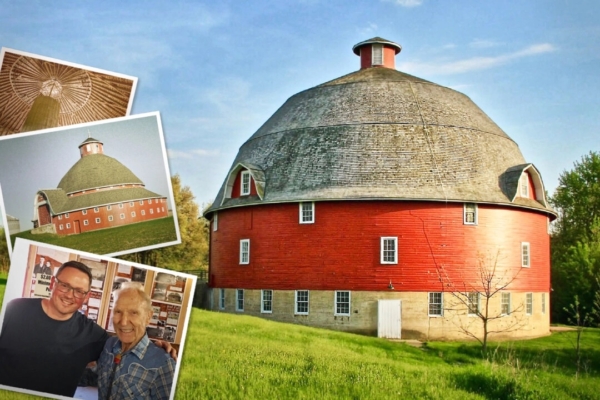These days, you might find it difficult to come across retro inventions that didn’t quite catch on back in the day for various reasons, such as the “Fifth Wheel” designed in the 1950s to simplify parallel parking, or the inflatable pump sneakers from the 1990s that claimed to make you jump like Jordan.
However, thanks to the efforts of Vincent Loveall from Jeffersonville, Indiana, dreams of reviving retro designs in agriculture such as the perfect round barns that emerged in the late 1880s may now have a chance to be preserved and passed on. Loveall told Epoch Times that round barns have not been well-preserved, often collapsing due to years of neglect, which is why he started capturing the beauty of these unique structures through photography since 1994.
Even though heritage buildings like charming wooden covered bridges are now protected by state governments, round barns are not included in the preservation list.
“Many farmers don’t truly understand what they have. Sometimes I can explain it to them,” said the 52-year-old Loveall.
Loveall claims to be one of the two experts in the United States who understand round barns the most. He founded the “American Round Barn Association” and established a community of at least 150 round barn owners and preservation experts nationwide, ready to provide assistance when someone needs a new round roof or curved wooden walls.
According to Loveall’s estimates, there are roughly over six hundred round barns in the United States, mostly concentrated in the Midwest but extending westward from Washington state to California. The East has fewer round barns, as crops like corn in the East are not as abundant as in the Midwest.
The trend of round barns truly began in 1874 when colonists were striving for agricultural advancement. Innovators found that constructing fully round brick or curved wooden barns could save costs and labor.
“If you break it down and make it rectangular, a round barn with the same length of wall can hold more space,” Loveall explained. “Less material is needed to build a round barn, and the interior layout has advantages.”
This layout typically includes a door leading to an aisle, which leads to a central donut-shaped ring where one can easily access all the outer animal stalls.
Loveall also described some other innovative designs. Many round barns have a hidden silo in the center that protrudes from the roof. Round barns used for dairy cows allow farmers to feed all livestock with just a short walk around. Some even feature self-supporting roofs without the need for beams.
“Another advantage is wind resistance,” he said. “The wind is more likely to go around a round barn rather than hitting the four corners of a square barn.”
Despite numerous advantages, most farmers merely smile and see it as a novelty, sticking to their familiar rectangular barns. Loveall says that less than a fraction of a percent truly use round barns.
Moreover, as the agriculture became more mechanized in the early 20th century, round barns became obsolete. When tractors emerged in 1910, more people started owning tractors, making the extra step to feed livestock less significant in the new mechanized era.
“After 1910, when the tractor came out, more people began to own tractors. Who cares about walking a few extra steps?” Loveall said. “The tractor can’t even fit into a round barn, among other issues.”
Expansion is also a problem. “How do you expand a round barn?” he questioned. Expanding a square barn is much simpler.
However, during their heyday, round barns did garner attention from some notable figures dedicated to enhancing agricultural efficiency. As a result, round barns almost became a uniquely American architectural form (although Loveall notes that Europe also has some).
“In 1793, George Washington built a 16-sided barn on his estate,” Loveall mentioned. “Round barns can be octagonal or completely round.”
The New York Crystal Palace, opened in 1853, featured an octagonal design with a massive central glass dome, becoming the first exhibition building in America. This may have sparked the idea of using round animal structures at county fairs.
The round barn movement was officially triggered in 1874 by Elliott Stewart, who constructed a fully functional octagonal barn. In 1889, Professor Franklin King of the University of Wisconsin built the first true round barn using curved horizontal wooden planks. This structure was endorsed by agricultural experiment stations and saw several individuals, such as Indiana lawyer and state senator Frank Littleton, applying for patents. Littleton owned the state’s largest round barn, measuring 102 feet (about 31 meters) in diameter, and patented its self-supporting roof.
In 1908, Horace Duncan, who was also involved in this patent work, erected the largest and most spectacular round barn in the United States. It matched Littleton’s barn in diameter, becoming Ohio’s largest barn, and was featured in the documentary “The Barn Raisers.” For its centenary in 2008, it was repainted in bright red.
All these promotion efforts led to what? There was a brief round barn craze in the Midwest. Books promoting the efficiency of round barns, professors at the University of Illinois erecting round barns on campus, and countless newspapers praising them sparked a round barn excitement across regions.
But Loveall says that was the “last wave of round barn construction frenzy.” To date, the University of Illinois campus still retains three round barns.
However, this movement “gradually subsided,” he added. After World War I, the rise of large machinery dealt the “final blow” to round barns’ fate. But Loveall is now advocating for a “renaissance.” Today, some “round barn enthusiasts” are starting to resurface, he says.
Loveall mentioned how round barns were previously neglected, left at the mercy of the elements, but since 2000, people have begun organizing to salvage these historical relics, relocating them to more prominent positions.
“They are no longer working barns,” he said. “They are being restored and repurposed for other uses, such as hosting weddings and events.”

